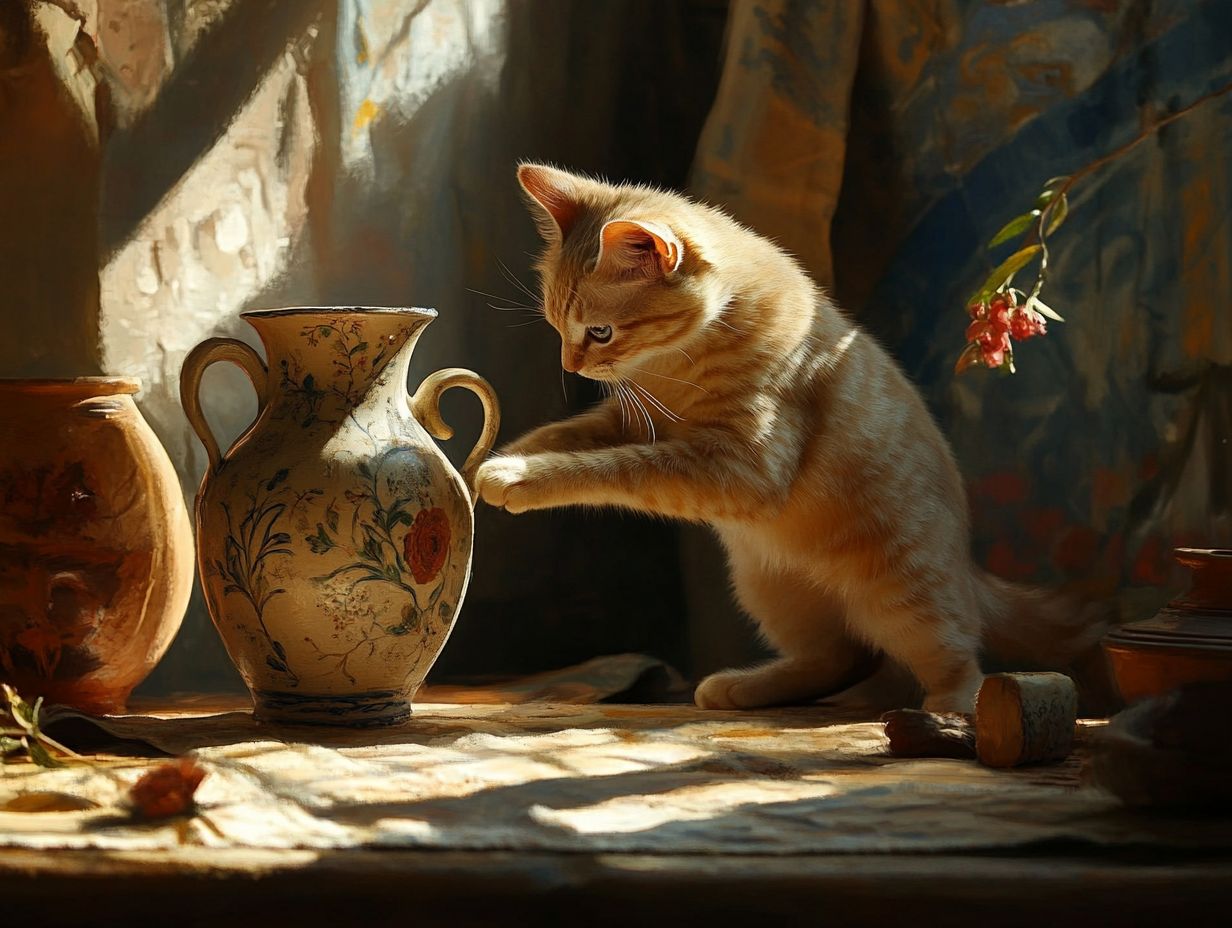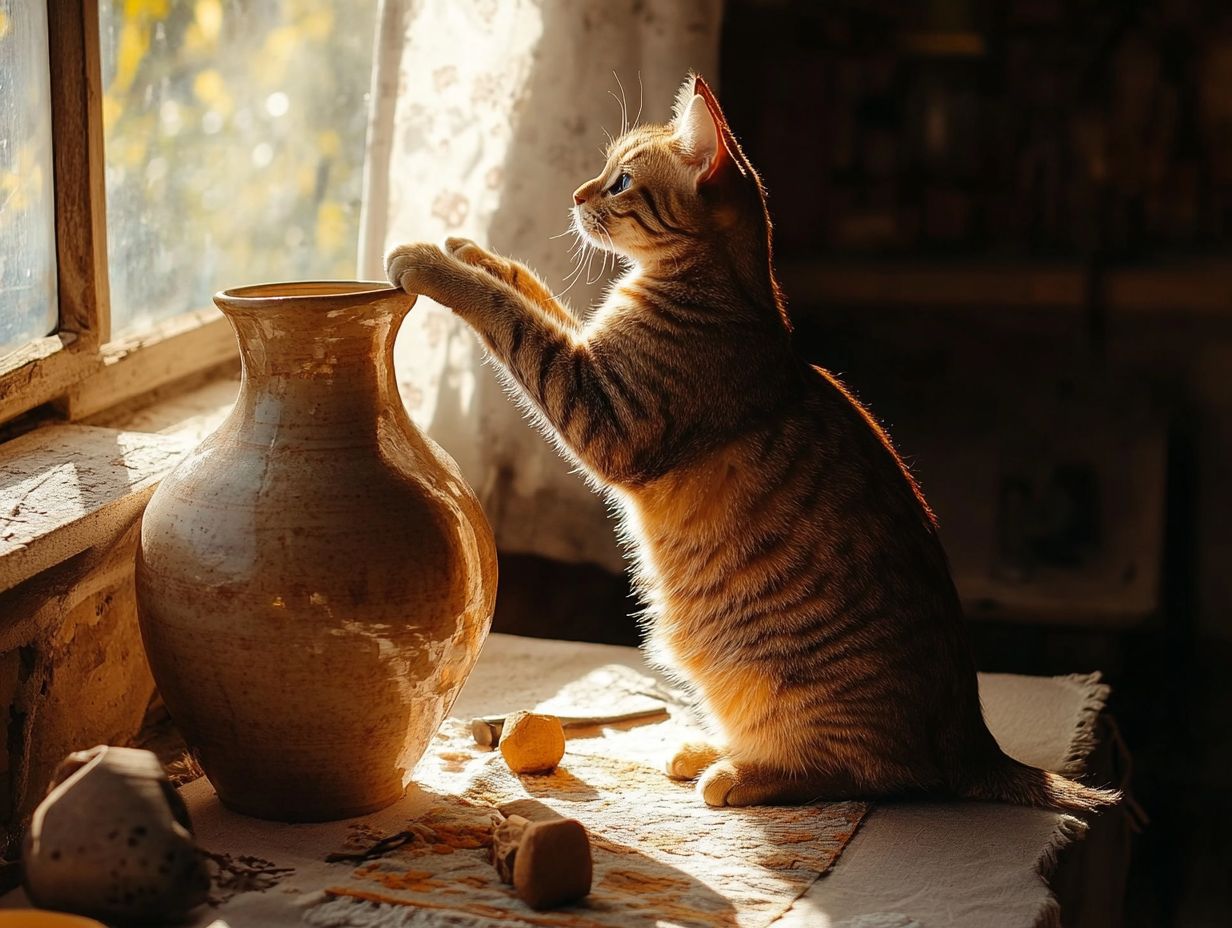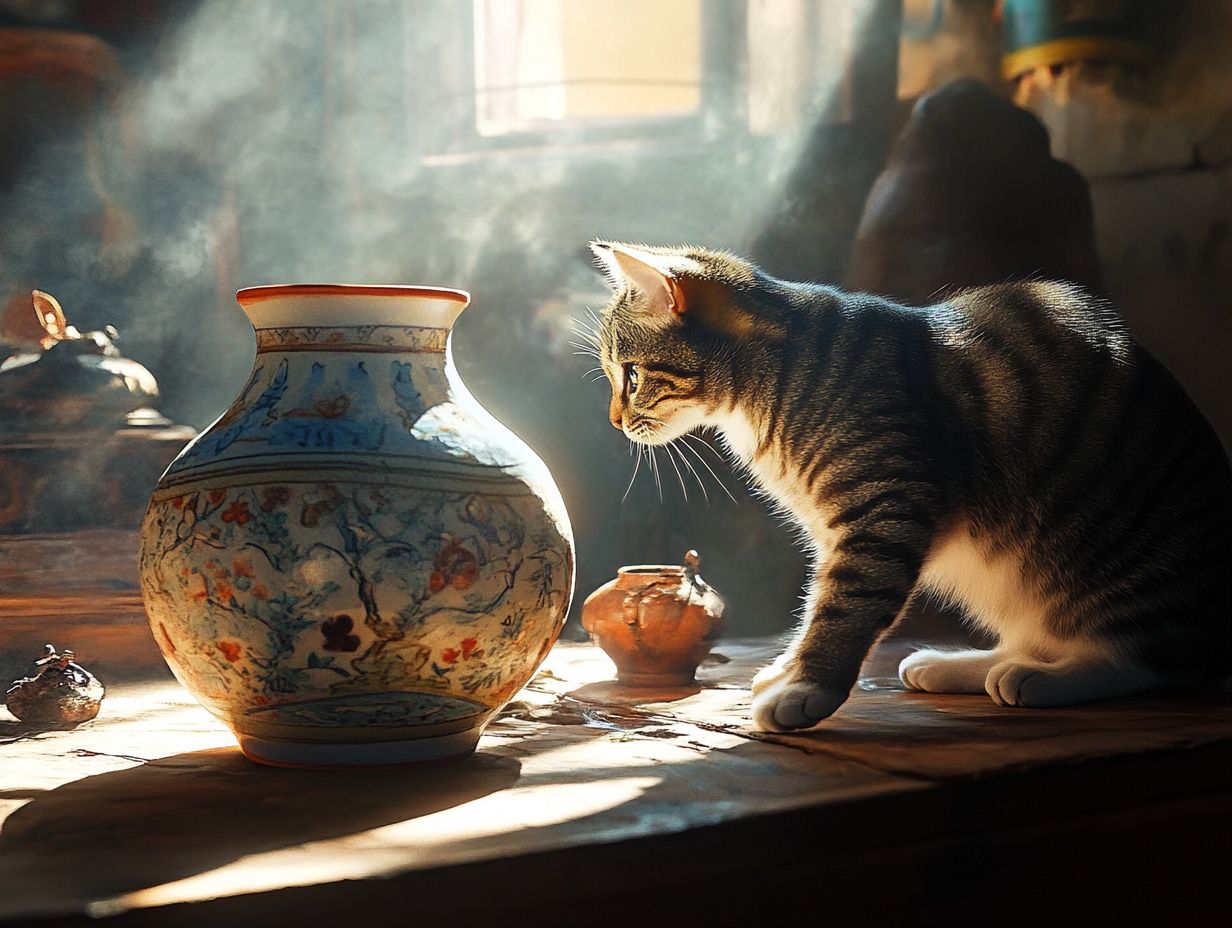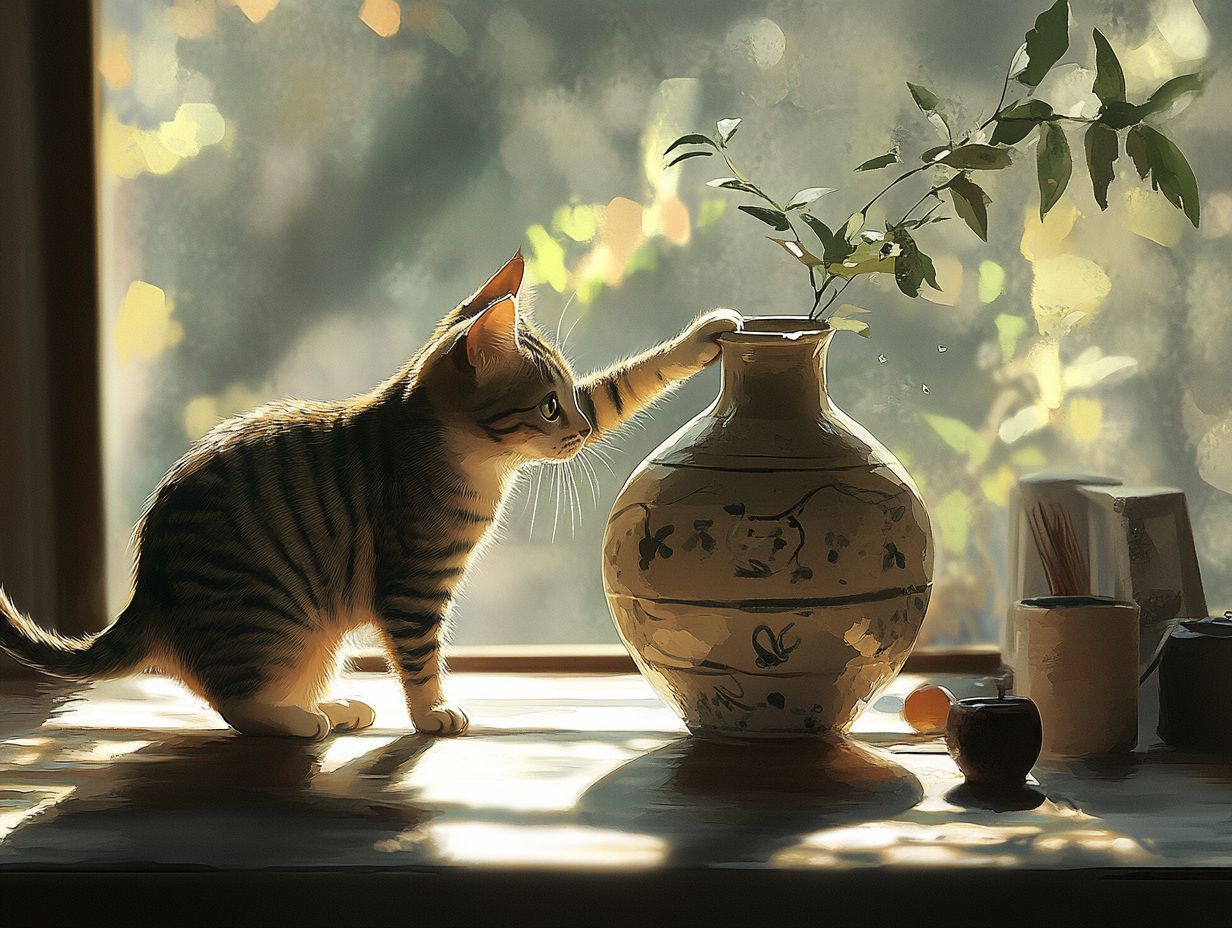Have you ever watched in disbelief as your cat, driven by curiosity, casually swats a glass off the table, leaving a trail of shattered glass and trinkets in its wake? This amusing, yet often frustrating behavior, raises questions about the instincts and playfulness that drive our feline friends to engage in such antics.
We will explore the reasons behind this curious habit, including their instinctual responses, the types of objects they prefer to target, and effective strategies to deter them. Additionally, we’ll discuss how environmental factors, such as cluttered spaces or lack of stimulation, contribute to this behavior.
We will also discuss whether this behavior is harmful or normal, its relation to attention-seeking tendencies, and how it compares to other common cat behaviors. Join us as we uncover the fascinating world of cat behavior!
Key Takeaways:

Why Do Cats Knock Things Over?
Cats are enigmatic creatures, and their playful behavior often captivates their owners, with knocking things over being one of the most common antics. Cats knock over objects for various reasons rooted in their natural feline instincts, including playfulness, curiosity, boredom, and the desire to explore their surroundings.
This behavior can serve as a means of interacting with their environment or satisfying their predatory instincts. Unfortunately, it often leads to the destruction of delicate items in their territory, such as fragile trinkets and furniture, which can be both amusing and frustrating for their owners.
What Are the Reasons Behind This Behavior?
Cats knock things over for various reasons, including boredom, instinctual behaviors, and attention-seeking actions.
Boredom: Cats may knock objects over when they feel bored and seek to stimulate their environment and engage their human companions.
Instincts: This behavior can also stem from instinctual drives. For instance, cats may display playful hunting reactions reminiscent of their ancestors’ hunting techniques. The act of swatting objects off tables or shelves allows them to replicate enjoyable aspects of hunting, providing stimulation and excitement.
Attention-Seeking Behavior: Additionally, cats may knock things over to garner attention from their owners, prompting interaction and strengthening their bond.
What Objects Do Cats Usually Knock Over?
Cats are notorious for knocking over a wide range of items, including fragile objects and furniture. This behavior is one of the most well-known—and at times, frustrating—aspects of cat ownership.
While exploring surfaces with their paws, cats are particularly prone to knocking over delicate items like glassware and decorative pieces. Additionally, they frequently send their toys tumbling as part of their playful antics.
Do Cats Prefer Certain Objects Over Others?
Yes, cats do have preferences for certain objects over others, driven by their curiosity and instinctual behavior. Their preference for specific toys can be influenced by factors such as the texture of the materials, the sounds they produce, and their movement.
For instance, cats that enjoy crinkly toys may be drawn to them because the sound and feel mimic the rustling of prey. Additionally, items that are bright and light enough to slide across the floor can capture a cat’s attention and encourage them to play.
How Can You Prevent Your Cat from Knocking Things Over?

The most effective way to prevent cats from knocking things over is to combine behavior modification with environmental enrichment. By understanding the natural instincts that drive this behavior, setting appropriate limits, and allowing these instincts to be expressed in safe ways, cat owners can effectively address the issue.
Providing a more stimulating and engaging environment for cats will also help reduce the likelihood of them knocking items over. Consider incorporating interactive toys, climbing structures, and dedicated playtime to redirect their playful instincts away from knocking things over.
What Are Some Strategies for Deterrence?
To discourage this behavior, employ specific reward-based training methods. For instance:
- Reward your cat with treats or affection when they play with appropriate toys instead of knocking objects over.
- Introduce clicker training to reinforce positive behaviors effectively.
Additionally, maintain a tidy space to minimize tempting objects. Regularly assess and adjust your environment to support your cat’s natural instincts in positive ways.
Understanding Individual Variation
Every cat is unique, and individual factors such as breed, genetics, and past experiences can influence their behavior. For example, some breeds may be more playful or curious than others, which can lead to different patterns of knocking things over. Understanding these nuances can help tailor strategies to manage this behavior effectively.
Developmental Stages
Cats exhibit different behaviors based on their developmental stages:
- Kittens: Often more playful and curious, they may knock over objects out of sheer energy and exploration.
- Adult Cats: Can show more deliberate behaviors often linked to seeking attention or boredom.
- Senior Cats: May experience changes in playfulness due to health issues or decreased energy, impacting their interest in knocking things over.
Addressing Stress and Anxiety
It’s crucial to recognize that stress or anxiety may lead to increased attention-seeking behaviors, including knocking things over. Look for signs of stress in your cat, such as changes in eating habits or increased hiding. Offering a safe, enriched environment can help alleviate these feelings.
Building a Stronger Bond
Engaging in regular playtime can fulfill a cat’s needs and reduce undesirable behaviors. Focus on establishing routines around interaction and play, which will strengthen your bond while redirecting their energy positively.
Myths About Cat Behavior
Many people believe that cats knock things over out of spite. However, this is a misconception; understanding the underlying motivations—like playfulness or boredom—can lead to better management strategies.
Professional Help
If the behavior persists or escalates, consider seeking help from a professional animal behaviorist or veterinarian. They can offer tailored guidance and strategies to address the behavior effectively.
Ongoing Learning
To better understand feline behavior, explore additional resources, such as books, articles, or webinars. Continuous learning about your cat’s needs and behavior can enrich your relationship.
In conclusion, understanding why cats knock things over involves recognizing their instincts, preferences, and individual differences. By employing a holistic approach, including behavior modification, environmental enrichment, and positive reinforcement, you can help manage this behavior effectively.
To prevent cats from knocking things over, effective strategies include redirecting their attention to toys and using methods like positive reinforcement to establish boundaries. It’s important to provide suitable outlets for their natural play instincts while also considering their emotional well-being and the dynamics of a multi-cat household.
Various cat-specific deterrents can also be employed, such as placing double-sided tape on surfaces, which discourages cats from meddling with items due to their aversion to the sticky sensation on their paws. Ensuring that the environment is enriching can significantly reduce undesirable behaviors.
A range of toys, including feather wands and interactive puzzle feeders, can stimulate their hunting instincts. Vertical spaces like cat trees or shelves offer safe opportunities for exploration at greater heights, catering to their need for physical engagement.
Are There Any Training Techniques?
Training your cat to prevent it from knocking things over is achievable through positive reinforcement and consistent methods tailored to the cat’s specific behavior. Utilizing various training techniques, such as clicker training, can assist pet owners in signaling the desired behaviors and redirecting energy toward appropriate activities. Clicker training involves making a clicking sound when the cat performs the desired action, which is immediately followed by a treat to encourage that behavior. This method not only aids in behavior modification but also fosters a deeper bond between the owner and the cat.
Rather than discouraging playful behavior, it’s more effective to redirect it toward suitable toys or interactive play, which can help improve their focus. With time and dedication, the training process can become an enjoyable bonding experience for both the cat and the owner.
Can This Behavior Be Harmful?
Knocking things over can pose risks to both cats and the fragile items in their environment. The playful yet predatory instincts of cats drive them to interact with various objects, which can result in broken trinkets, injured paws, or even harm to the cat if they encounter sharp or dangerous items. Understanding the potential dangers can help owners take preventive measures.
What Are the Potential Dangers of Cats Knocking Things Over?
The risks associated with cats knocking things over extend beyond immediate mess and chaos; they can also pose threats to both the cat and its surroundings. These seemingly harmless behaviors can lead to serious dangers, including the potential for injury from sharp objects such as broken glass or exposed corners of furniture. There is also the risk that a cat may swallow small items that have fallen, resulting in significant medical issues.
Additionally, delicate possessions like decorative figurines and cherished antiques may be irreparably damaged in the wake of such disturbances. Using deterrents like catnip-infused toys and providing plenty of safe spaces can help mitigate these risks. For more insights, check out this article on Why Cats Knock Things Over.
By being aware of these risks, cat owners can create a safer environment that minimizes accidents while still accommodating their cat’s natural playfulness.
Is This Behavior Normal?

Yes, knocking things over is a normal aspect of feline behavior, deeply rooted in their instincts and natural play. Cats often engage in this behavior as a way to explore their environment, allowing them to interact with their surroundings in ways that stimulate their curiosity and predatory instincts. It’s essential to recognize that this behavior can be influenced by their developmental stages, with kittens, adults, and seniors exhibiting different tendencies.
Understanding that this behavior is an expression of their instinctual nature can help owners better redirect their cats’ playful actions while ensuring they provide plenty of appropriate opportunities for engagement. For example, older cats may engage in this behavior less frequently, whereas kittens may be more enthusiastic explorers.
Do All Cats Exhibit This Behavior?
While many cats exhibit the behavior of knocking things over, not all felines engage in this action, as it often depends on their unique personalities, environmental factors, and genetics. Interestingly, some breeds like Munchkin, Bombay, and Cornish Rex are more prone to this playful destruction than others. Understanding the breed characteristics can assist owners in managing expectations and behaviors.
Building trust and understanding between the cat and owner is crucial in positively impacting behavior. Addressing stressors such as boredom or anxiety can also help mitigate tendencies to engage in destructive actions. Recognizing feline body language and providing environmental enrichment are key components in fostering a harmonious living space.
A cat exhibiting high curiosity levels and instinctual behaviors can significantly influence whether it decides to send items tumbling to the floor. For instance, a cat that demonstrates high curiosity may engage in exploratory behavior by pushing objects, while others may be more reserved and less inclined to partake in such antics. According to studies published in the Journal of Feline Medicine and Surgery, these behaviors are rooted in their natural instincts.
Additionally, a cat’s environment—such as the presence of enticing toys or stimulating playmates—can greatly influence this behavior. Cats raised in urban settings may exhibit different patterns than those in rural areas, highlighting the fascinating diversity within the feline world. This interplay of nature (genetics) and nurture (upbringing) plays a crucial role in shaping feline behavior.
What Are Some Other Common Cat Behaviors?
Besides knocking things over, cats commonly engage in behaviors such as climbing on vertical spaces like cat trees, scratching, and pouncing. These actions are natural and instinctual. It is important to encourage and support them by providing an environment that accommodates these needs, using tools like interactive puzzle toys, laser pointers, or feather wands to keep them engaged.
Do These Behaviors Have Any Similarities to Knocking Things Over?
Many common cat behaviors, such as knocking things over, stem from their natural instincts and playful tendencies. This playful act often arises from a strong curiosity and a deep-seated predatory instinct inherited from their ancestors. Additionally, the perceptual nuances of feline body language, such as tail position and ear orientation, can indicate their emotional state during these activities.
Behaviors like climbing to high places, scratching surfaces, and playing with or chasing certain objects serve not only as good sources of exercise and territory marking but also offer opportunities for exploration and practicing hunting skills. These instinctual behaviors highlight cats’ strong need to engage with their environments and satisfy their innate curiosity and playfulness. This desire for discovery and adventure reflects the instinctive playfulness present in all cats, whether domesticated or wild.
Frequently Asked Questions
Why do cats knock things over?

Cats have a natural instinct to explore and play with objects using their paws. Knocking things over is a way for them to engage in this behavior and release energy. It can also be a form of attention-seeking or predatory play. Understanding this behavior as a symptom of boredom or lack of stimulation is crucial for addressing it effectively.
Is it normal for cats to knock things over?
Yes, it is a common behavior for cats. It is their way of interacting with their environment and can be seen as a form of play or hunting. Cats may also knock over trinkets or other objects out of boredom if not adequately stimulated. Providing enriching activities from an early age can help prevent unwanted behaviors later on.
Do all cats knock things over?
No, not all cats exhibit this behavior. Individual differences in temperament and breed traits can affect a cat’s likelihood to engage in knocking things over. Breeds like Munchkin, Bombay, Cornish Rex, Sphynx, Devon Rex, Somali, and Bengal might exhibit different patterns.
How can I stop my cat from knocking things over?
You can try providing your cat with more interactive toys, such as puzzle toys, and designated play areas like cat trees, to redirect their behavior. Additionally, consider incorporating positive reinforcement techniques like clicker training or reward systems for desired behaviors, as punishment can lead to anxiety and distrust. Also, ensure enough mental and physical stimulation to prevent knocking over furniture or other items.
What if my cat knocks over expensive or fragile items?
You can try using deterrents such as double-sided tape or placing items out of reach. It may also be helpful to train your cat with positive reinforcement to associate knocking over with negative consequences. Engaging them with catnip or creating vertical spaces can also help.
Is there a medical reason for cats knocking things over?
In some cases, cats may knock things over due to vision problems, hyperthyroidism, or other medical conditions. If you notice a sudden change in your cat’s behavior, particularly excessive knocking leading to injury, it is best to consult with a veterinarian to avoid further issues and ensure a safe and rich environment for your cat.
Signs of Stress and Anxiety
Signs of stress that might lead to this behavior include hiding, excessive vocalization, or changes in eating habits. Strategies for reducing stress include providing safe spaces, consistent routines, and ensuring adequate interaction and playtime.
Behavior Modification
For those looking to redirect knocking behaviors, a step-by-step guide includes identifying triggers, increasing interactive playtime, and being patient and consistent with training techniques.
Engaging with Your Cat
Engaging with a cat during play can strengthen the human-cat bond and positively influence their behavioral responses. This bond is vital to their overall well-being and can mitigate unwanted behaviors.
Myth Busting
It’s essential to address misconceptions about cat behavior, such as the idea that knocking items over is purely mischievous. In reality, this behavior often stems from instinctual roots and curiosity.
Professional Help
Indicators that suggest when a cat owner should seek professional help include sudden changes in behavior or excessive knocking leading to injury. Regular veterinary check-ups can help rule out medical conditions that could cause behavioral changes.